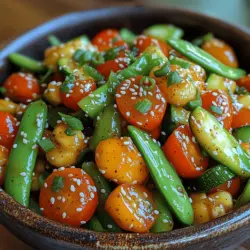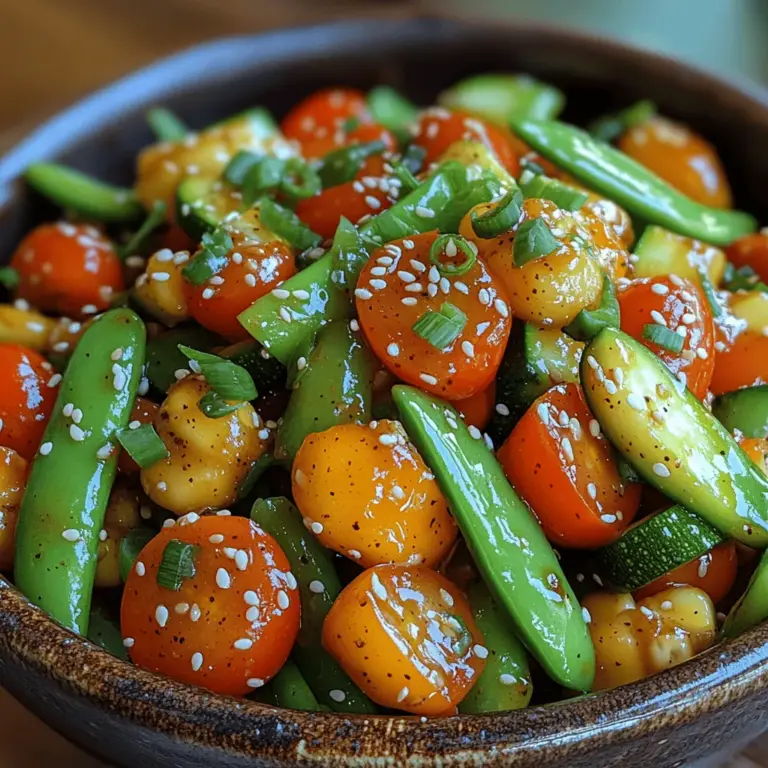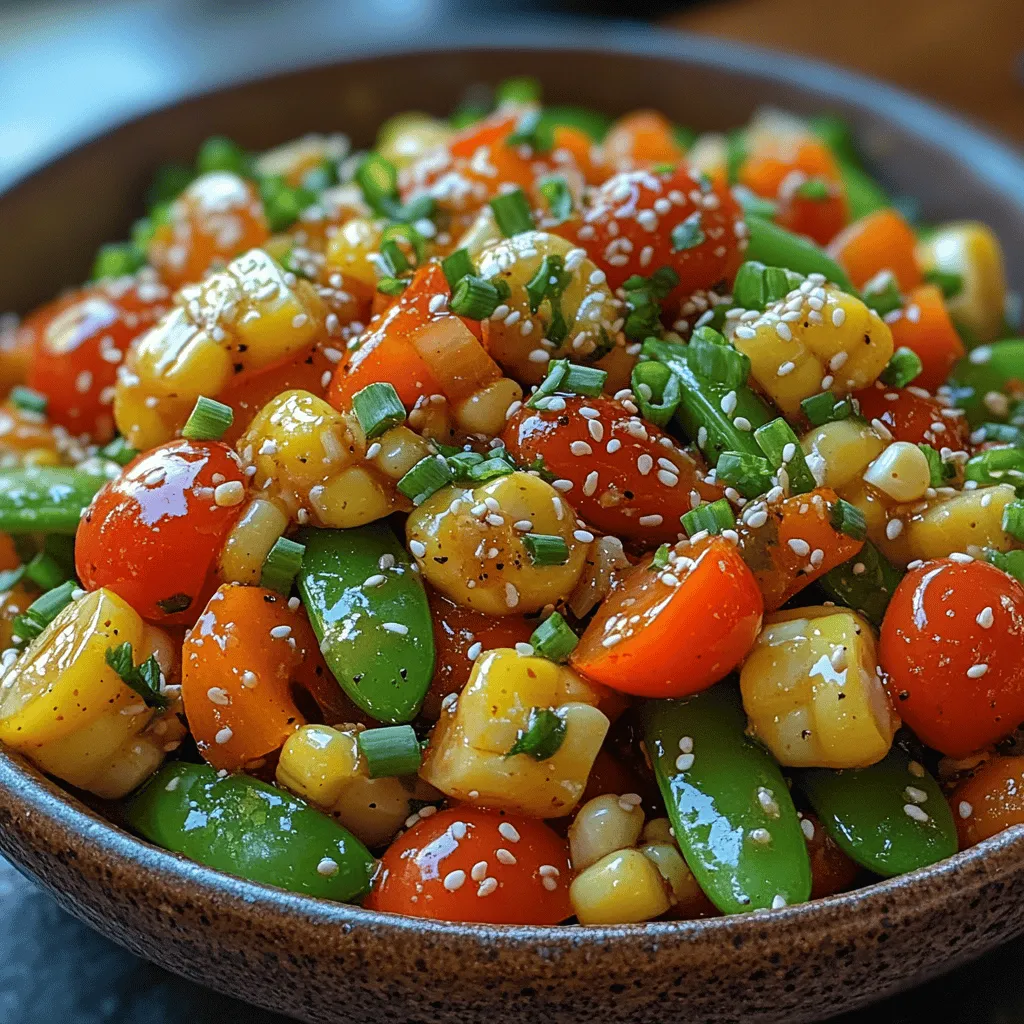Introduction
As the warm sun graces the summer months, there’s nothing quite like the vibrant and fresh flavors of a garden vegetable stir-fry. This dish not only captures the essence of summer but also serves as a celebration of the season’s bountiful harvest. Crisp & Colorful Summer Garden Vegetable Stir-Fry is a fantastic way to showcase a medley of seasonal vegetables, bringing together their natural colors and flavors in a quick and delightful meal.
The beauty of this stir-fry lies in its simplicity and speed. In just a matter of minutes, you can create a dish that is not only satisfying but also bursting with nutrients. By incorporating a variety of fresh vegetables, you’re not just enhancing the taste of your meal; you’re also reaping numerous health benefits. Each vegetable contributes its own unique set of vitamins and minerals, making this stir-fry a powerhouse of nutrition.
Whether served as a light main course or a vibrant side dish, this recipe is sure to be a hit at your summer gatherings or cozy family dinners. Let’s dive into the ingredients that make this dish shine and explore the preparation steps that ensure a delicious outcome.
Exploring the Ingredients
The success of any stir-fry lies in the quality and variety of its ingredients. For a Crisp & Colorful Summer Garden Vegetable Stir-Fry, selecting the freshest vegetables is key. Here’s a closer look at some of the primary ingredients that will elevate this dish:
Snap Peas
Snap peas are a fantastic addition to any stir-fry. With their sweet flavor and crisp texture, they not only add crunch but also a delightful pop of color. Nutritionally, snap peas are rich in vitamins A, C, and K, as well as fiber and protein. Their bright green hue signifies their nutrient density, making them a smart choice for health-conscious cooks.
Zucchini
Zucchini is another star ingredient that brings versatility to the table. With its mild flavor, zucchini absorbs the tastes of surrounding ingredients while adding a lovely tender crunch. It’s low in calories yet high in vitamins and minerals, particularly vitamin C and potassium. This summer squash is also a great source of hydration, making it perfect for those hot days.
Bell Peppers
Bell peppers are available in a spectrum of colors, including red, yellow, green, and orange, each offering its own distinct flavor profile. These vibrant vegetables are not only visually appealing but also packed with nutrients like vitamins A and C, fiber, and antioxidants. The sweetness of bell peppers enhances the overall flavor of the stir-fry, making them a staple in any vegetable dish.
Cherry Tomatoes
Cherry tomatoes bring a burst of sweetness and juiciness to the stir-fry. Their bright red color adds visual interest, while their high levels of vitamins C and K make them a nutritious choice. These little gems also contain lycopene, an antioxidant linked to several health benefits, including improved heart health and reduced risk of certain cancers.
Corn
Sweet corn, with its golden kernels, adds a delightful sweetness and chewy texture to the dish. Rich in fiber, vitamins B and C, and essential minerals, corn makes the stir-fry more filling and satisfying. Its natural sweetness balances the other savory flavors, creating a harmonious blend.
Carrots
Carrots provide not only crunch but also a vibrant orange hue that catches the eye. They are an excellent source of beta-carotene, which the body converts into vitamin A, essential for maintaining healthy vision and skin. Additionally, carrots are high in fiber and low in calories, making them a nutritious addition to this colorful blend.
Fresh vs. Frozen Ingredients
While fresh vegetables are always preferable for their taste and texture, frozen options can be a convenient and nutritious alternative. If you find yourself short on time or unable to access fresh produce, frozen vegetables maintain their nutritional value and can be used in this stir-fry without compromising quality. However, it’s essential to thaw and drain them properly to avoid excess moisture in your dish.
Optional Ingredient Substitutions
One of the appealing aspects of stir-frying is its adaptability. You can easily swap out any of the above ingredients based on your dietary preferences or what you have on hand. For instance, if you’re looking for a low-carb option, you might replace zucchini with sliced mushrooms or cauliflower. For those who enjoy heat, adding sliced jalapeños or chili peppers can give the dish a spicy kick.
Preparation Steps Explained
Preparation is key when it comes to stir-frying; a clean and organized kitchen will ensure a smooth cooking process. Here’s a detailed guide on how to prepare your ingredients effectively.
Importance of Prep Work in Stir-Frying
Before you even turn on the stove, it’s crucial to have all your ingredients prepped and ready to go. Stir-frying is a quick cooking technique that requires high heat and fast movements, meaning you won’t have time to chop vegetables while the pan is sizzling.
Washing and Cutting Vegetables
1. Wash Thoroughly: Start by washing all your vegetables under cold running water. This step removes any dirt, pesticide residues, or bacteria. It’s especially important for leafy greens and root vegetables.
2. Snap Peas: Trim the ends of the snap peas and remove the string along the seam for the best texture.
3. Zucchini: Cut the zucchini into half-moons or matchsticks, depending on your preference. Aim for uniform sizes to ensure even cooking.
4. Bell Peppers: Slice the bell peppers into strips or bite-sized pieces. Remove the seeds and white pith, which can be bitter.
5. Cherry Tomatoes: Halve the cherry tomatoes to allow their juices to release during cooking, adding flavor to the stir-fry.
6. Corn: If using fresh corn, carefully slice the kernels off the cob. If using frozen, ensure they are thawed and drained.
7. Carrots: Peel the carrots and cut them into thin rounds or julienne them for quicker cooking.
Keeping a Clean and Organized Cooking Area
A tidy workspace can significantly enhance your cooking experience. Keep a trash bowl nearby for quick disposal of vegetable scraps, and always have your cutting board and knife within reach. Having your utensils and spices organized will also save you precious time during the cooking process.
Cooking Techniques for Perfect Stir-Fry
Now that your ingredients are prepped, it’s time to delve into the cooking techniques that will ensure a successful stir-fry.
Explanation of the Stir-Fry Technique
Stir-frying involves cooking ingredients quickly over high heat, which allows them to retain their texture, flavor, and nutrients. The key to a perfect stir-fry lies in the heat; using a wok or a large skillet ensures even cooking and prevents steaming.
Importance of High Heat and Quick Cooking
When stir-frying, it’s essential to preheat your pan until it’s very hot before adding any oil. This helps create a non-stick surface and sears the vegetables, locking in their flavors. Once the oil is added, work quickly to add your vegetables in stages, starting with those that take longer to cook, such as carrots and bell peppers, and finishing with quicker-cooking items like snap peas and tomatoes.
Stay tuned as we continue to explore the full recipe for this Crisp & Colorful Summer Garden Vegetable Stir-Fry, including detailed cooking instructions, tips for achieving the best results, and answers to common questions about stir-frying techniques.
The Role of Aromatics: Garlic and Ginger
Aromatics play a crucial role in elevating the flavor profile of any dish, and in our Crisp & Colorful Summer Garden Vegetable Stir-Fry, garlic and ginger are the stars of the show. When sautéed, garlic releases a rich, pungent aroma that serves as the foundation for many Asian-inspired dishes. Ginger, on the other hand, adds a zesty warmth that complements the natural sweetness of the vegetables. Together, they create a fragrant base that enhances the overall taste experience, making each bite more enjoyable.
Step-by-Step Breakdown of the Cooking Process
To achieve a perfectly cooked vegetable stir-fry, following a systematic approach is essential. Here’s a detailed guide to get you started:
1. Preparation of Ingredients: Begin by washing and chopping your vegetables into uniform pieces. This ensures even cooking and presents a visually appealing dish. Common choices for your stir-fry include bell peppers, zucchini, carrots, snap peas, and broccoli.
2. Heating Oil: Heat a large skillet or wok over medium-high heat. Once hot, add a high smoke point oil, such as canola or grapeseed oil. The right temperature matters; if the oil is not hot enough, the vegetables will steam rather than sauté, leading to a less desirable texture.
3. Sautéing Aromatics: Add minced garlic and ginger to the hot oil. Timing is crucial here: sauté them for about 30 seconds until fragrant but not browned, as burnt garlic can impart a bitter taste. This step releases essential oils and sets the stage for a flavor-packed stir-fry.
4. Adding Vegetables in the Right Order: Introduce your hardier vegetables first, such as carrots and broccoli, as they require longer cooking times. After about two minutes, add softer vegetables like bell peppers and zucchini. This staggered approach ensures that each vegetable is cooked to perfection while retaining its crunch.
Flavor Enhancements and Seasoning
Overview of the Sauce Ingredients
The beauty of this stir-fry lies not just in the vegetables but also in the sauce that brings everything together. A basic stir-fry sauce typically includes soy sauce, sesame oil, rice vinegar, and optional elements like honey or chili flakes for added flavor.
Soy Sauce vs. Tamari: Gluten-Free Options
For those following a gluten-free diet, tamari is an excellent alternative to traditional soy sauce. It has a similar taste profile but is made without wheat, making it suitable for gluten-sensitive individuals. Whichever option you choose, ensure to use low-sodium varieties to keep the dish healthy.
The Role of Sesame Oil and Rice Vinegar in Flavor Balance
Sesame oil adds a rich, nutty flavor that enhances the overall taste of the stir-fry. It should be used sparingly as a finishing oil rather than a cooking oil, as it has a lower smoke point. Rice vinegar contributes a mild acidity that balances the savory notes of the soy sauce, making the dish bright and refreshing.
Tips for Adjusting Seasoning Based on Personal Preference
While the suggested sauce ingredients provide a fantastic base flavor, feel free to adjust the quantities according to your taste. If you prefer a sweeter sauce, add a teaspoon of honey or agave syrup. For a spicier kick, incorporate chili paste or red pepper flakes.
Importance of Tasting and Adjusting Flavors During Cooking
As you cook, continually taste your stir-fry and adjust the seasoning if needed. This practice not only ensures that the flavors meld beautifully but also helps you develop your palate, making you a more intuitive cook.
Serving Suggestions
Presentation Ideas for the Stir-Fry
Once your stir-fry is cooked, presentation is key to making the dish appealing. Serve it in a large bowl, garnished with fresh herbs like cilantro or green onions. A sprinkle of sesame seeds can add a lovely crunch and visual contrast.
Suggested Accompaniments: Rice, Quinoa, or Noodles
While the stir-fry is delicious on its own, pairing it with a side of rice, quinoa, or noodles can take the meal to the next level. For a traditional approach, serve the stir-fry over steamed jasmine or brown rice. Alternatively, quinoa offers a protein-packed option, while rice noodles can provide a delightful texture.
Ideas for Serving Leftovers
Leftovers from this stir-fry are versatile and can be enjoyed in various ways. Consider making a wrap with the stir-fry filling, using a tortilla or lettuce leaves for a light option. Alternatively, you can mix the leftovers with scrambled eggs for a quick breakfast or toss them into an omelet for added flavor.
Health Benefits of a Vegetable-Rich Diet
Discussion on the Importance of Vegetables in a Balanced Diet
Incorporating a variety of vegetables into your diet is essential for optimal health. Vegetables provide vital nutrients, including vitamins, minerals, and fiber, which support overall well-being. A colorful plate not only looks more appealing but also signifies a range of nutrients that contribute to a balanced diet.
Nutritional Benefits of Each Vegetable Used in the Stir-Fry
– Bell Peppers: Rich in vitamin C and antioxidants, bell peppers support immune function and skin health.
– Zucchini: Low in calories and high in water content, zucchini helps keep you hydrated and provides essential nutrients.
– Carrots: Packed with beta-carotene, carrots are great for eye health and have anti-inflammatory properties.
– Snap Peas: These crunchy treats are high in protein and fiber, promoting digestive health and providing sustained energy.
– Broccoli: A powerhouse of vitamins K and C, broccoli also contains compounds that may have cancer-fighting properties.
How This Dish Fits into Various Dietary Lifestyles (Vegan, Vegetarian, Gluten-Free)
This Crisp & Colorful Summer Garden Vegetable Stir-Fry is incredibly versatile, making it suitable for various dietary lifestyles. It’s naturally vegan and vegetarian, full of plant-based nutrients. By choosing tamari over soy sauce, it can easily cater to gluten-sensitive diets. Its simplicity allows you to modify ingredients based on your preferences or dietary restrictions.
Conclusion
The Crisp & Colorful Summer Garden Vegetable Stir-Fry is not just a meal; it’s a celebration of seasonal ingredients and a testament to the joys of healthy cooking. With its vibrant colors, delightful textures, and a multitude of flavors, this dish is not only simple to prepare but also packed with nutritional benefits.
As you try this recipe, don’t hesitate to experiment with different vegetables and flavors. The beauty of stir-frying lies in its adaptability; you can use whatever is fresh and in-season. Embrace the joy of cooking and the satisfaction of nourishing your body with wholesome meals that are both delicious and healthy. Happy cooking!


